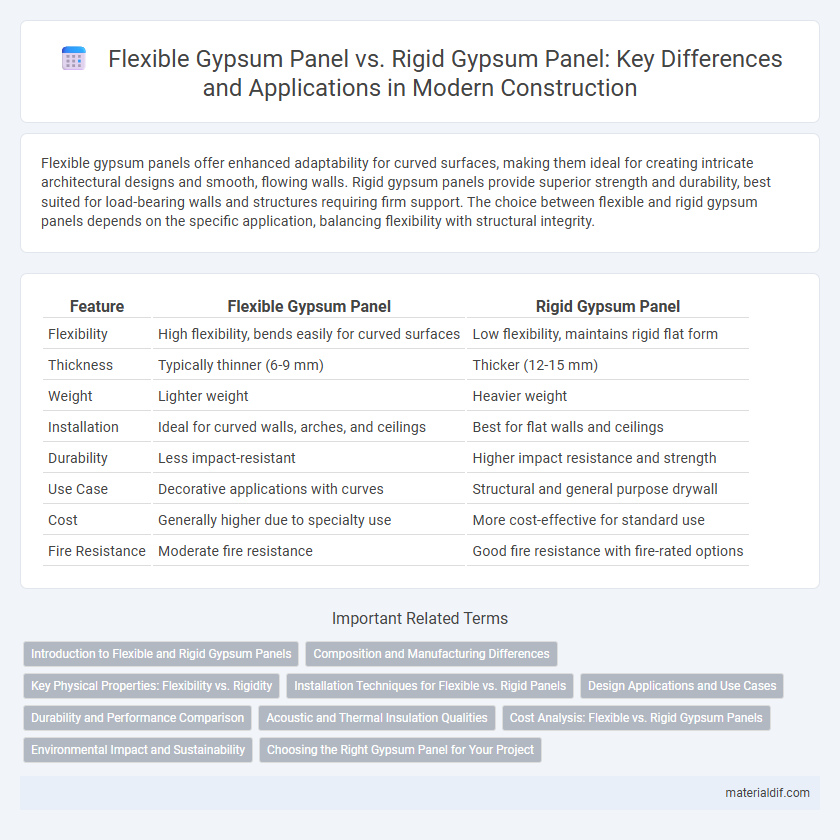Flexible gypsum panels offer enhanced adaptability for curved surfaces, making them ideal for creating intricate architectural designs and smooth, flowing walls. Rigid gypsum panels provide superior strength and durability, best suited for load-bearing walls and structures requiring firm support. The choice between flexible and rigid gypsum panels depends on the specific application, balancing flexibility with structural integrity.
Table of Comparison
| Feature | Flexible Gypsum Panel | Rigid Gypsum Panel |
|---|---|---|
| Flexibility | High flexibility, bends easily for curved surfaces | Low flexibility, maintains rigid flat form |
| Thickness | Typically thinner (6-9 mm) | Thicker (12-15 mm) |
| Weight | Lighter weight | Heavier weight |
| Installation | Ideal for curved walls, arches, and ceilings | Best for flat walls and ceilings |
| Durability | Less impact-resistant | Higher impact resistance and strength |
| Use Case | Decorative applications with curves | Structural and general purpose drywall |
| Cost | Generally higher due to specialty use | More cost-effective for standard use |
| Fire Resistance | Moderate fire resistance | Good fire resistance with fire-rated options |
Introduction to Flexible and Rigid Gypsum Panels
Flexible gypsum panels are designed to bend and curve easily, making them ideal for creating curved walls and ceilings in architectural designs. Rigid gypsum panels provide a sturdy, flat surface commonly used for standard wall and ceiling installations, delivering excellent fire resistance and soundproofing properties. Both types leverage gypsum's natural fire-resistant qualities but differ primarily in flexibility and application versatility.
Composition and Manufacturing Differences
Flexible gypsum panels incorporate a gypsum core blended with polymers and additives that enhance bendability, while rigid gypsum panels consist primarily of a dense, hardened gypsum core for structural support. Manufacturing flexible panels involves controlled curing processes and the integration of reinforcing fibers or mats to maintain flexibility without cracking. Rigid panels undergo a traditional drying and pressing method that maximizes compressive strength and rigidity for load-bearing applications.
Key Physical Properties: Flexibility vs. Rigidity
Flexible gypsum panels exhibit superior bending capabilities, allowing them to conform to curved surfaces without cracking, making them ideal for intricate architectural designs. Rigid gypsum panels provide enhanced structural strength and stability, ensuring durability in load-bearing wall applications. The choice between flexible and rigid panels hinges on balancing flexibility for creative shapes and rigidity for support and longevity.
Installation Techniques for Flexible vs. Rigid Panels
Flexible gypsum panels require installation methods that accommodate their bendable nature, allowing them to conform to curved or irregular surfaces with minimal cutting. Rigid gypsum panels demand precise measurements and straight cuts to ensure proper alignment and stability on flat walls or ceilings. Fastening techniques differ as flexible panels often need additional adhesive support alongside standard screws to maintain their shape and secure attachment.
Design Applications and Use Cases
Flexible gypsum panels are ideal for curved walls, arches, and intricate architectural details due to their ability to bend without cracking, making them perfect for creative and non-linear design applications. Rigid gypsum panels provide superior strength and stability, commonly used in flat wall surfaces, ceilings, and partitions where structural integrity is crucial. Design applications for flexible panels include custom curves in theaters and exhibition spaces, while rigid panels are preferred in residential and commercial construction for efficient wall assembly and fire-resistant partitions.
Durability and Performance Comparison
Flexible gypsum panels offer enhanced resistance to bending and impact, making them ideal for curved surfaces and dynamic environments. Rigid gypsum panels provide superior structural strength and load-bearing capacity, ensuring long-term durability in standard wall applications. Performance-wise, flexible panels excel in adaptability, while rigid panels maintain consistent stability and fire resistance.
Acoustic and Thermal Insulation Qualities
Flexible gypsum panels offer superior acoustic absorption compared to rigid gypsum panels, reducing noise transmission in residential and commercial spaces. Rigid gypsum panels provide enhanced thermal insulation due to their denser composition, improving energy efficiency in building envelopes. Combining both types can optimize overall acoustic comfort and thermal performance in interior wall systems.
Cost Analysis: Flexible vs. Rigid Gypsum Panels
Flexible gypsum panels generally incur higher upfront costs due to specialized materials and manufacturing processes, while rigid gypsum panels offer more economical pricing suitable for large-scale projects. Installation of flexible panels may demand skilled labor, increasing overall expenses, whereas rigid panels allow quicker, more cost-effective application with standard techniques. Long-term maintenance costs tend to be comparable, but flexible panels provide better durability in curved or irregular surfaces, potentially reducing repair costs in complex architectural designs.
Environmental Impact and Sustainability
Flexible gypsum panels generate less construction waste due to their adaptability and reduced breakage compared to rigid gypsum panels, enhancing sustainability. Rigid gypsum panels often require more energy-intensive manufacturing processes, resulting in higher carbon footprints relative to flexible alternatives. Both panel types are recyclable, but flexible panels support eco-friendly building designs by improving material efficiency and reducing resource consumption.
Choosing the Right Gypsum Panel for Your Project
Flexible gypsum panels offer enhanced adaptability for curved or uneven surfaces, making them ideal for innovative architectural designs, while rigid gypsum panels provide superior strength and durability for standard flat walls and ceilings. Selecting the right gypsum panel depends on project requirements such as flexibility, load-bearing capacity, and installation environment. Consider factors like moisture resistance, fire rating, and ease of finishing to ensure optimal performance and longevity in your construction project.
Flexible gypsum panel vs Rigid gypsum panel Infographic

 materialdif.com
materialdif.com